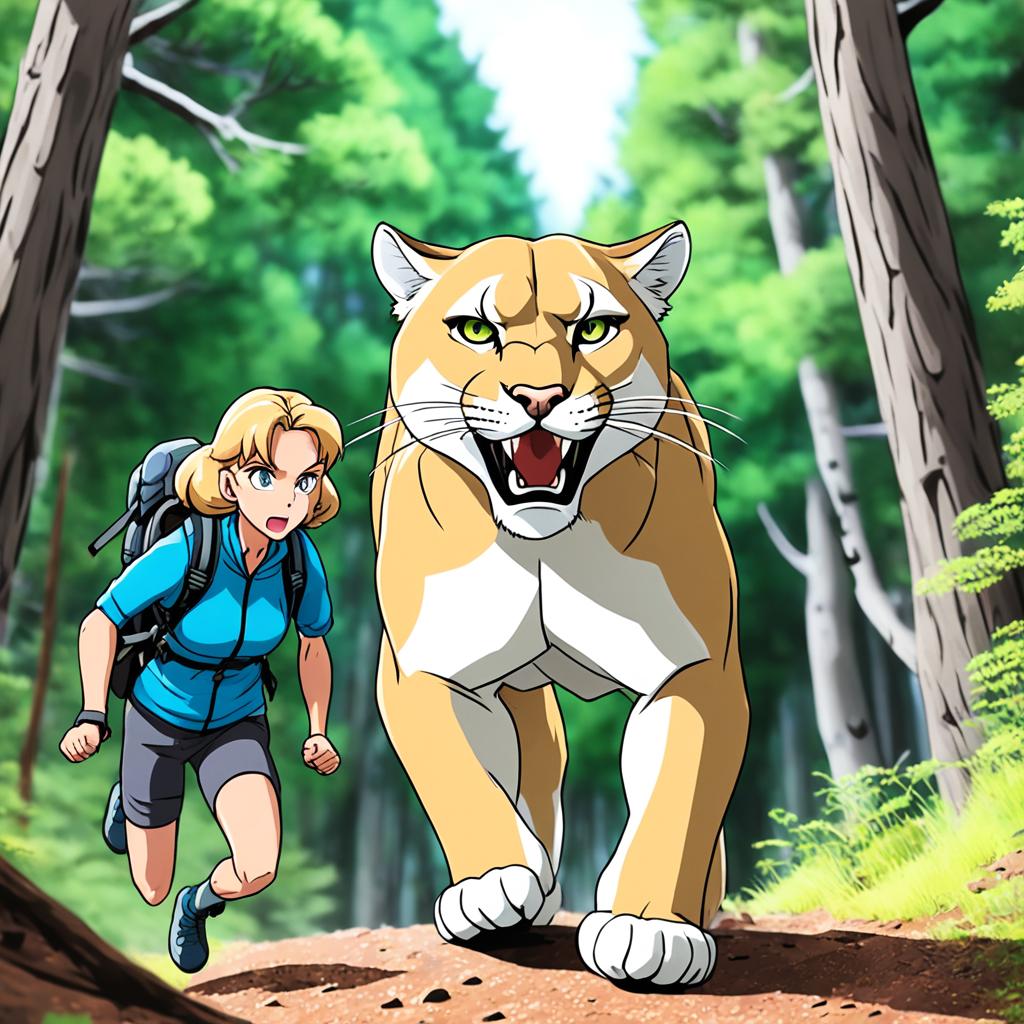Have you ever wondered how far a cougar can roam in a single day? These majestic creatures, also known as mountain lions, are renowned for their stealth and agility. But just how wide is their territory, and how much ground can they cover? Let’s delve into their roaming habits, behavior, and the astonishing distances they can traverse.
Cougars are the largest wild cats in North America, weighing between 63 and 90 kg for males and 40 and 50 kg for females. They are solitary animals, except for mothers with young. Cougars are most active at dusk and dawn but can roam and hunt throughout the day or night, covering up to 80 km in a single day. They have ranges up to 300 sq km and are known to prey on various animals such as deer, wild sheep, elk, rabbits, birds, and small animals.
Curious to know more about their roaming patterns, hunting behavior, and what to do if you encounter one in the wild? Let’s explore further!
Roaming Patterns and Behavior of Cougars
During late spring and summer, young cougars that are one to two years old become independent from their mothers. These young cats often roam widely in search of an unoccupied territory as they attempt to establish their own home range. This is when they are most likely to come into contact with people.
Cougars mark their territory using mounds of scraped earth, pine needles, and other forest litter soaked with urine and feces. They have distinctive tracks that resemble those of a house cat but are the size of a baseball.
Tips for Interacting with Cougars

If you find yourself encountering a cougar in the wild, it’s crucial to follow safety precautions and know what to do. Remember, these big cats are powerful and potentially dangerous, so it’s essential to stay calm and take appropriate actions to ensure your safety and the safety of the cougar.
Here are some tips to help you navigate cougar encounters:
- Don’t run: Running may trigger the cougar’s instinct to chase, as it sees sudden movement as prey. Instead, stay calm and maintain your ground.
- Back away slowly: While keeping your eyes on the cougar, take slow steps backward. Avoid turning your back on the animal and maintain eye contact to show that you are aware of its presence.
- Make yourself look bigger: Open your jacket, raise your arms, and hold them above your head. Grab a branch or any object to extend your perceived size. This can help deter the cougar from approaching.
- Speak firmly: In a loud and assertive voice, talk to the cougar. This lets it know that you are a human and not an easy target. Use commanding phrases like “No!” or “Go away!”
- Yell and throw rocks: The goal is to convince the cougar that you are a potential threat and not prey. Shout loudly, clap your hands, and throw rocks or sticks toward the cougar while maintaining a safe distance.
- Give the cougar an escape route: Allow the cougar to have a clear pathway to retreat. Never corner or trap the animal, as it may feel threatened and become defensive.
- If attacked, fight back: In the unfortunate event that a cougar approaches and attacks you, use any available object as a weapon. Hit, punch, or kick the cougar’s sensitive areas, such as its eyes, nose, or throat, to protect yourself.
Remember, cougars typically avoid confrontations with humans. By following these safety precautions and knowing what to do, you can minimize the risks associated with cougar encounters and ensure a safer experience in their natural habitat.
Here’s an image that illustrates a person standing tall and making themselves look bigger during a cougar encounter:
Hiking and Camping in Cougar Country
When planning a hiking or camping trip in areas known to have cougars, it’s crucial to prioritize safety precautions to ensure a secure and enjoyable experience. Here are some essential tips to keep in mind:
- Hike or camp in groups: It’s always safer to travel in groups of two or more. Cougars are less likely to approach larger groups, as they tend to avoid confrontation.
- Make noise: Cougars are known to be elusive and stealthy, so it’s important to make enough noise to alert them of your presence. This can be achieved by talking or singing while hiking and setting up camp.
- Carry protective gear: Equip yourself with a sturdy walking stick, which can act as a defensive tool if necessary. Additionally, consider carrying pepper spray, a non-lethal option for self-defense against wildlife.
- Keep children close: Children can be more vulnerable to cougar encounters due to their smaller size. Ensure they stay close and under control at all times, and educate them about what to do if they come across a cougar.
- Be aware of cougar signs: Familiarize yourself with signs of cougar activity, such as tracks, scat, or scratches on trees. If you spot any signs, it’s an indication that cougars may inhabit the area, and you should proceed with caution.
- Check local wildlife sightings: Before heading out on your trip, contact local park offices or authorities to inquire about recent wildlife sightings, including cougar activity. This information can help you make informed decisions about your hiking or camping location.
If you encounter cougar kittens while hiking or camping, it’s important to leave the area immediately. The female cougar will be protective of her young and may perceive your presence as a threat. Respect their space and give them the opportunity to stay safe.
By following these safety precautions, you can enjoy the beauty of cougar country while minimizing the risk of unwanted encounters.
Mountain Lion Movements and Dispersal

Mountain lions, also known as cougars, are fascinating creatures that exhibit unique behaviors in their quest for survival. In this section, we will explore their remarkable long-range movements and dispersal behavior.
Mountain lions are wide-ranging animals that cover vast distances in search of resources such as food, water, suitable habitat, and potential mates. They have the remarkable ability to travel long distances, ensuring their survival in diverse environments. Dispersal is a crucial behavior exhibited by subadult mountain lions when they become independent from their natal home ranges.
Why do mountain lions disperse?
Dispersal is vital for maintaining genetic diversity within mountain lion populations. By venturing away from their natal range, subadult mountain lions reduce the risk of inbreeding and increase the chances of creating genetically diverse and healthy populations.
During the dispersal period, young mountain lions undertake extensive long-range movements, leaving their familiar surroundings behind. These journeys often take them through various habitats and terrains, allowing them to explore new territories and establish their own home ranges.
The Average Daily Movement Rate
On average, mountain lions travel approximately 2.3 miles per day. This movement rate remains relatively consistent for both males and females and does not vary significantly between seasons.
By covering such distances, mountain lions increase their chances of encountering suitable resources and potential mates, ensuring the survival and expansion of their populations. These long-range movements contribute to the ecological balance and genetic diversity of mountain lion populations.
As mountain lions embark on their remarkable journeys, they navigate vast landscapes, facing challenges and adapting to the ever-changing environment. Their long-range movements and dispersal behavior play vital roles in their survival and the stability of their populations.
Mountain Lion Range and Habitat
Cougars, also known as mountain lions, can be found throughout the state of Washington, where suitable cover and prey are available. They have a diverse geographic range, spanning various terrains and habitats.
Adult male cougars have larger home ranges compared to females, typically ranging from 50 to 150 square miles. Female home ranges are about half the size of males. The size of the home range depends on several factors, including the age of the cougar, the time of year, the type of terrain, and the availability of prey.
Cougars are adaptable creatures that utilize different types of habitats for hiding and hunting. They often seek shelter in steep canyons, rock outcroppings, dense brush, and forests. These areas provide cover and camouflage, allowing them to approach their prey undetected.
When it comes to prey availability, cougars primarily target larger animals such as deer, elk, moose, mountain goats, and wild sheep. These prey species provide the necessary nutrition for their survival. However, cougars are opportunistic hunters and will also target smaller animals like raccoons, coyotes, rabbits, and rodents when larger prey is scarce.
| Fact | Details |
|---|---|
| Habitat | Steep canyons, rock outcroppings, dense brush, and forests |
| Geographic Range | Throughout Washington state |
| Adult Male Home Range | 50 to 150 square miles |
| Female Home Range | About half the size of males |
| Main Prey | Deer, elk, moose, mountain goats, and wild sheep |
| Secondary Prey | Raccoons, coyotes, rabbits, and rodents |
Cougar Hunting Regulations and Management
In areas where cougar hunting is allowed, specific regulations and seasons are in place to ensure sustainable management of cougar populations. Understanding these regulations is crucial for hunters and wildlife enthusiasts alike.
Cougar Hunting Seasons
Cougar hunting seasons are divided into early and late seasons, providing hunters with ample opportunities to pursue this elusive big cat. The timing of these seasons may vary depending on the region and state regulations. It is important to consult local hunting authorities or the Washington Department of Fish and Wildlife for accurate information regarding cougar hunting seasons in your area.
Bag Limit
When it comes to cougar hunting, there is a bag limit in place to ensure the conservation of cougar populations. In most cases, the bag limit allows for the harvest of one cougar per license year. This limit helps maintain a balanced population and prevents overhunting.
Reporting Requirements
After harvesting a cougar, hunters are required to report the harvest within 72 hours. This reporting process is essential in monitoring and managing cougar populations effectively. Additionally, hunters must have the pelt sealed within five days of the harvest as part of the reporting process.
Management Strategies
The Washington Department of Fish and Wildlife actively implements management strategies to ensure the long-term viability of cougar populations. These strategies aim to strike a balance between the conservation of cougars and the safety of human populations in cougar country. They involve scientifically informed decision-making, habitat modification around residential areas, and public education to minimize conflicts.
By modifying the habitat around their homes and using appropriate fencing, people can help create a safer environment that reduces potential conflicts with cougars. The Department of Fish and Wildlife encourages individuals living in cougar country to take these precautions seriously and play an active role in managing cougar populations.
By adhering to hunting regulations, reporting harvests, and implementing conservation measures, both hunters and non-hunters can contribute to the sustainable management of cougar populations, ensuring their long-term survival.
Living with Cougars: Prevention and Safety Measures
Preventing conflicts with cougars is essential for ensuring the safety of your family and pets. One effective measure is to modify the habitat around your home. Install proper lighting to discourage cougars from approaching, and avoid landscaping with plants that attract deer, as they can indirectly attract cougars.
Additionally, consider using fencing as a deterrent. While it is not foolproof, it can help discourage cougars from accessing your property. It is important to note that cougars are generally elusive and attacks on humans are extremely rare. However, if you live in cougar country, taking precautions is advisable.
Be vigilant when you have small children, always keeping them within sight and ensuring their safety. Use caution with pets and livestock, keeping them securely confined in enclosed areas. If you spot a cougar or have a close encounter, it’s crucial to report it to local wildlife authorities. They can provide important information and take appropriate steps to ensure the safety of both humans and cougars.


